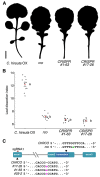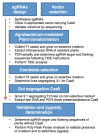CRISPR/Cas9-Mediated Mutagenesis of RCO in Cardamine hirsuta
- PMID: 32085527
- PMCID: PMC7076481
- DOI: 10.3390/plants9020268
CRISPR/Cas9-Mediated Mutagenesis of RCO in Cardamine hirsuta
Abstract
The small crucifer Cardamine hirsuta bears complex leaves divided into leaflets. This is in contrast to its relative, the reference plant Arabidopsis thaliana, which has simple leaves. Comparative studies between these species provide attractive opportunities to study the diversification of form. Here, we report on the implementation of the CRISPR/Cas9 genome editing methodology in C. hirsuta and with it the generation of novel alleles in the RCO gene, which was previously shown to play a major role in the diversification of form between the two species. Thus, genome editing can now be deployed in C. hirsuta, thereby increasing its versatility as a model system to study gene function and evolution.
Keywords: CRISPR/Cas9; Cardamine hirsuta; RCO; leaf development.
Conflict of interest statement
The authors declare no conflict of interest.
Figures




References
-
- Vuolo F., Kierzkowski D., Runions A., Hajheidari M., Mentink R.A., Gupta M.D., Zhang Z., Vlad D., Wang Y., Pecinka A., et al. LMI1 homeodomain protein regulates organ proportions by spatial modulation of endoreduplication. Genes Dev. 2018;32:1361–1366. doi: 10.1101/gad.318212.118. - DOI - PMC - PubMed
Grants and funding
LinkOut - more resources
Full Text Sources
Research Materials

